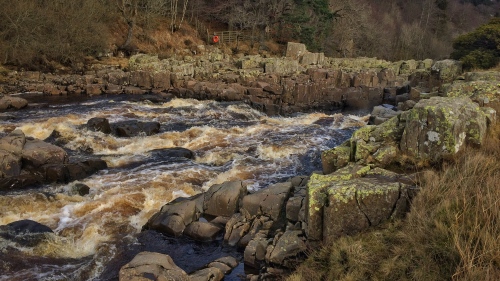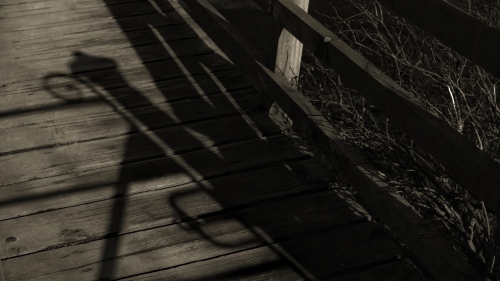The curlews are back.
As a phrase it’s simple and short. You can pack so much into short phrases. In Shakespeare’s ‘King Lear’, the pivotal moment in the whole play is written as just ‘He died’. There’s no how or why or wherefore. No big announcement or speech. No high drama. Just two words.
The curlews are back.
it’s four words, granted, but in the upper reaches of the North Pennines it says so much. In any normal winter it would mark the end of it. A return to normal and the reassurance that everything will be OK again. With the numbers of curlew and lapwing and oystercatcher and redshank on the ever decline in the North of England, it marks something of a sigh of relief to hear those first whirring, bubbling, almost alien calls echoing around the fells.
Hearing those sounds also reminds me I’m in the Upper Dale, which is where I got to after leaving Cronkley Bridge. Heading ever onwards, downstream towards the distant sea.
Today the river level is up a bit and the water is running at a fair pace. Not quite in spate, but in a decided hurry nonetheless.
Following the Pennine Way, the path is well marked and maintained, but moves away from the course of the river as it swings right and left and right in big sweeping curves beneath Dime Holm Scar. Up on Bracken Rigg the path flatten out to a brief plateau and the gentle mounds of a bronze age settlement.
The path next meets the river just before the crushing plants of High Force Quarry loom up on the opposite bank. A still very active whinstone quarry, it’s a present reminder of the industrial activity that’s shaped all of the landscape around here. This now barren and wild landscape bears the marks everywhere of centuries of mining and quarrying and the wealth and poverty of those that came to make their fortune from what lies beneath the surface.

But the landscape is vast too, and easily swallows up the industrial workings. A mere dot on the wider view.
And opposite, barely visited and overlooked by the rumble of machines and steel and rubber tyres, is one of the most spectacular waterfalls in this part of the Pennines.

Bleabeck Force is the final leap where two becks from way up the fell meet and tumble down in a race to get to the river. From the Tees there is a small concrete beam bridge that gives you a view up the lower cascades and the top of the highest one. A short scramble over the boulders rewards you with a great view of the main fall and plunge pool below. The water levels on these fellside becks and gills are fickle and I’ve walked past this many times and never seen it look quite so spectacular. I’ll definitely make the journey up on a spate day.

Back at the Tees, the river is still in a bit of a hurry. Skipping over the rocky bed which itself is becoming increasingly jarred and jagged with much larger outcrops appearing to grow up from the river bed. These angular intrusions breaking up the flow of the river and churning it white and chaotic.

A quarter of a mile further on the river meets a wall of whinstone and is forced into a narrow channel down one side. The full width of the river – maybe 10 metres or more squeezed into a gap no more than a metre in places. here the water shows it’s true potential. You sense it’s speed and sheer will power.

It’s sprinting now.

Then with one last twist and pirouette it leaps.

and over a 35m vertical drop. In one, two steps.
As it collides with the pool below, large quantities launch back up against the incessant downforce.
This is High Force. The ‘biggest’ waterfall in England. I’m not sure how they quantify these things. It’s not the highest or the widest, but when in full flow it certainly has the largest volume of water per metre drop. Or something like that. Well, it’s impressive and it’s the biggest tourist attraction in the upper dale.
There’s two ways to see this. From the carpark beside the High Force Hotel on the main dale road there’s a very attractive path that leads down the steep gorge to the base of the water falls for a few pounds entrance. Here you get to be as close as you’d want to get o experience the full power of the falls. When it’s in full flow the spray can be so much it’s difficult to see the falls. But the sight of that much water in full motion and the continuous roar is a real experience.
Alternatively, from the Pennine Way on the other side of the river, you can get scarily close to the very top of the falls and watch the water disappearing down to the river below. Further downstream, there’s a little path off the main route that takes you to a small, unmarked viewing clearing where you get to see the whole waterfall in it’s full glory. And this one is free.

Breaking yourself away from watching the waterfall, the path continues through a very ancient juniper forest while the river runs through a steep wooded gorge below and largely unseen for about a mile. The path meets the river again at the next bridge.

It’s bridges we’ve really come to see and this is a fine one. Holwick Head Footbridge links the main Teesdale road with Holwick Head House and the track down towards Holwick village and the Earl of Strathmore’s estates.

Upper Teesdale is split into two major estates – to the north is the Raby estate of Raby Castle and the ownership of the Lord Barnard. It can be distinguished by its whitewashed buildings and dark blue paintwork. To the south of the river at this point is the estate of the Earl of Strathmore who has a country house at Holwick Lodge. Holwick Head Bridge marks a link between the two estates and was originally built by the then Duke of Cleveland in 1896 and was known at the time as the Duke’s Bridge.

It was rebuilt as a single footbridge by Durham County Council in 1998, but still retains the rather grand cast iron gateposts of the original bridge made by Motley and Green of Leeds.

It’s a simple steel girder construction over a central stone pillar with wooden decking. It’s a popular bridge with walkers making circular trips along the river, or just as a stopping place to stand and watch the river run below. But its still only a footbridge. The first proper road bridge across isn’t for another six or seven miles yet which makes you realise just how isolated the south side of the river is. These bridges may be few and far between, but they’re vital for getting around this landscape.

From the top of the bridge the river is busy on its way and largely ignores the passing of people overhead. It may have lost some of its width since High Force, but it’s lost none of its sense of purpose. There’s no slowing down or pausing to catch a breath. It will need all its energy to get past the next bit.






